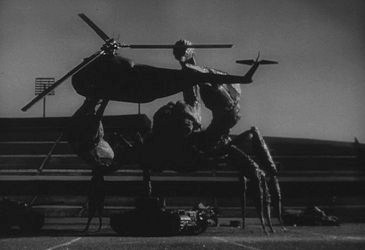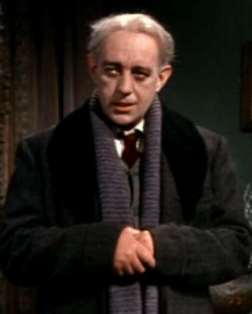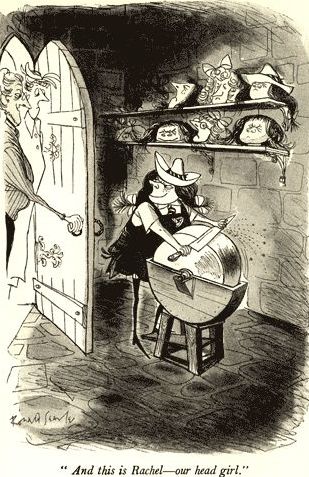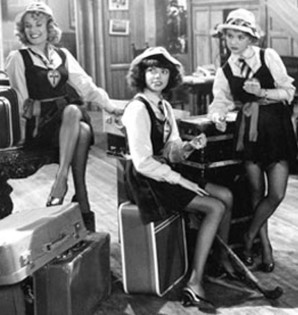 Tarantula (1955)
Tarantula (1955) 
The Black Scorpion (1957) 
The Deadly Mantis (1957) 
The ‘50s giant bug craze was part of the larger atomic monster sub-genre which started with The Beast from 20,000 Fathoms and went on full tilt for the next decade. These were B-pictures—or C-pictures—where sparing expense was always a factor. Still, they tended not to be too cheap.
The movies followed the same general plot set up in The Beast from 20,000 Fathoms (1953) and solidified in Them! (1954). They were constructed as mysteries, except the titles gave it away. In an isolated location, a soon-to-be hero would discover a series of deaths: human, wildlife, and livestock. The culprit was a giant monster, normally either created, or set free by man’s new scientific knowledge. A team would be set up to track and destroy the monster, made up of a romantic lead (normally that guy who discovered the bodies, though not always), an attractive girl, and a short, elderly scientist played by a skilled character actor. Over the course of the picture, these people would be called in when it made no sense to do so, and take on missions obviously suited better for professionals specifically trained for it. Toward the end of the film, often after the monster was assumed to be killed, the location would switch to a large city where the military would destroy the beast. Once the monster’s existence was known, no one would doubt or hesitate and the government and military would work in perfect harmony. These were positive films. While things might get a bit rocky, in the end, our government is on our side, our military can take care of any threat, and Americans all pull together. Yeah… It was a different time. To keep the budgets low, much of the military action is delivered via stock footage of ships at sea and jets taking off or landing.
Them! is the quintessential, and best, of the bug films, and so, gets its own review. The Black Scorpion, The Deadly Mantis, and Tarantula do a good job of filling out the field. All are reasonably good fun for a summer afternoon.
Tarantula (1955)
When secretive scientist Gerald Deemer’s (Leo G. Carroll) partner turns up dead of an unlikely disease, the local doctor, Matt Hastings (John Agar) gets suspicious. But it is going to be a while before he discovers that a giant Tarantula is now running around the desert, killing cattle and the occasional person. Until then, he flirts with Deemer’s sexy new assistant, Stephanie ‘Steve’ Clayton (Mara Corday) and chats to old-timey Sheriff Andrews (Nestor Paiva).
“I knew Leo G. Carroll was over a barrel when Tarantula took to the hills” — Science Fiction/Double Feature.
Tarantula varies from the formula a bit more than the others, but then it came out only a year after Them! The main difference is the merging in of the ‘40s-era mad scientist story. The monster is not the result of nuclear testing, but of Professor Deemer’s attempt to make a super-food. His food was unstable and we get over-sized rats and guinea pigs before the still growing tarantula escapes. Our triad is Deemer, the local doctor, and the cute assistant, but as Deemer is less help than the scientists in these types of films normally are, the sheriff gets to fill in on the heroic team. It is unfortunate as Carroll is the best thing about the film.
The isolated location is the Arizona desert where Deemer has set up his mysterious lab. We never get to a large city, with the local town having to supply all the panicking civilians. We do get the required stock footage Air Force jets.
Tarantula is mildly enjoyable, and while the best in terms of cinematography and acting, overall, it is the weakest of the three. It is too laid back, taking far too long to get to our giant bug. That gives more time for the romance to develop, which isn’t in itself a bad thing. But if your movie is called Tarantula, no one is watching to see the romantic leads chat while they smoke (they always smoke…), sitting on some desert rocks. There needs to be more monster action than coy smiles and a mad scientist ranting.
Director Jack Arnold is known for his genre work on It Came From Outer Space (1953), the last of the great Universal horror films, The Creature From the Black Lagoon (1954) and its weak sequel Revenge of the Creature (1955), along with The Incredible Shrinking Man (1957).
The Black Scorpion (1957)
After a volcanic eruption, people living near an isolated Mexican village begin to disappear. A pair of geologists, one American (Richard Denning) and one Mexican (Carlos Rivas), on their way to study the volcano, find a damaged police car, dead officer, and abandoned baby. They soon find themselves in the middle of the mystery given away by the title. On the less monstrous side, they meet the local ranch owner and hot woman, Teresa Alvarez (Mara Corday), so of course we have a romance blooming.
The ‘50s and ‘60s giant bug craze did not produce many original films and The Black Scorpion isn’t one. It is two-thirds a note-for-note rehash of Them! and one-third The Beast From 20,000 Fathoms. Hey, if you are going to copy, copy from the best.
Our isolated desert location has moved south to Mexico, where once again a home is found damaged and a child found alive—this time a baby instead of a catatonic little girl. I know all these films follow a formula, but that’s getting pretty close to plagiarism. Our hero soon teams up with an elderly scientist and strikes up a romance with the only female to get more than three lines—played once again by Tarantula’s Mara Corday. Once it is clear they are dealing with giant bugs, it is only a matter of time before they lower themselves into the monsters’ lair, and beat by beat, we follow the story of Them! The scorpions even make the same sound as the ants did. The one deviation from Them! is that the all-knowing, elderly, short scientist has a smaller part, and just pops up when needed. So we get a second young scientist to complete the triad, though for some reason, he never has a chance with the girl.
There is a child I quickly learned to hate who repeatedly runs recklessly into danger. The kid is stuck in to raise the stakes—putting a child in jeopardy is a standard, old-school monster movie bit—but it doesn’t work because the child is too stupid.
While most of the giant monster movies used puppets or men in suits, The Black Scorpion was one of the few to use stop motion, executed by Willis O’Brien, the man who brought King Kong to life twenty years earlier. In the final years of his career, he no longer had access to the resources he needed. Still, O’Brien’s work gives the film a magical quality most similar films lacked. He even uses some models left over from Kong. With passable acting, a reasonable pace, amiable characters, and O’Brien’s scorpions, The Black Scorpion is one of the better giant bug pictures.
The Deadly Mantis (1957)
A series of mysterious disappearances in the arctic leads the military to call in paleontologist Ned Jackson (William Hopper). His keen use of a magnifying glass allows him to work out that the culprit is a giant praying mantis, recently released from the ice. Ned teams up with Colonel Joe Parkman (Craig Stevens) and hot magazine editor Marge Blaine (Alix Talton) to stop the giant creature.
Once again, the film follows the ‘50s giant monster template. The secluded area where the monster first appears has moved north (or returned north as that’s where things start in The Beast from 20,000 Fathoms). Our triad is a soldier, the girl he romances, and a scientist, with the change that our scientist is neither old nor short. Plot-wise, we’ve seen it all before.
Where The Deadly Mantis stands out is in how literal it makes its metaphor. This is a cold war film and the mantis is a stand in for the Russians. The film begins with an explanation of the US radar system—requested by the actual US government to be added to the picture to calm average citizens and assure them that we are always on the lookout for the commie attack. And it isn’t a brief comment. Buckle up for a full-on lecture with all the maps and stock footage you could ever desire. But don’t worry, there will be even more stock footage later.
The military is all over the film—with stock footage jet fighters taking off every five minutes—and is competent and caring (though individual soldiers are a bit girl-crazy). Civil defense is often mentioned and there’s very much a feeling of “we’re all in this together against those sneaky commie mantises.” The in-film government even requests the help of the civilian Ground Observer Corps, a real organization of normal folks who watched for enemy aircraft—it was shut down in 1959. Strangely, this never gets too heavy or feels like we’re joining Joseph McCarthy. Partly that’s due to the characters being likable and partly due to the focus being on everyone working together by choice rather than giving up rights for safety or questioning our neighbors.
The acting wasn’t going to win any awards, but is passable. The cinematography gets by with the help of some genuinely spooky fog-filled scenes. And, grading on a curve, the effects are good. The mantis is one of the best non-stop-motion creatures. The before-mentioned fog helps. We get to see plenty of the monster, but often in situations that hide the weakness of the model.
OK, so it doesn’t make sense or follow any kind of science. Bugs don’t work this way. Air force pilots don’t lead army soldiers in ground-based attacks. But then that kind of silliness is a given going in. While worse in almost every way than Tarantula, its pace and silliness makes it more fun.








 When Guiness was given the script, he thought it was a mistake, and that it was meant for the other mainstay and master of the movement, Alastair Sim. When he was assured it was meant for him, he based his performance on Sim, and had his makeup done as a caricature of Sim. I would have loved to see Sim in the part as he’d have been wonderful, but that would have deprived us of Guiness’s amazing performance and that’s too high a price.
When Guiness was given the script, he thought it was a mistake, and that it was meant for the other mainstay and master of the movement, Alastair Sim. When he was assured it was meant for him, he based his performance on Sim, and had his makeup done as a caricature of Sim. I would have loved to see Sim in the part as he’d have been wonderful, but that would have deprived us of Guiness’s amazing performance and that’s too high a price.
 Ronald Searle created the world of St. Trinian’s in a series of one frame cartoons. Think of it as if Charles Addams had focused on boarding school girls. He drew the first few before he became a POW during WWII. The cartoons took a darker and funnier turn after the war, often filled with the smiling young girls and their deceased victims. Searle and his girls became extremely popular.
Ronald Searle created the world of St. Trinian’s in a series of one frame cartoons. Think of it as if Charles Addams had focused on boarding school girls. He drew the first few before he became a POW during WWII. The cartoons took a darker and funnier turn after the war, often filled with the smiling young girls and their deceased victims. Searle and his girls became extremely popular. Another marvelous invention is the 6th form girls. The cartoons just had little monsters. The film adds older girls—too old to be in school, which is one of the jokes. “Pogo” (and yes, you are supposed to think about how she got that nickname) is married. “Not officially,” chimes in Miss Fritton, but you get the point. These elder girls are just as evil, but less random. They scheme and plan and add seduction to their armory, and are the basis for the St. Trinian’s Girl fetish in Britain, where the idea of the sexy Catholic school girl was replaced. And this allows for an additional type of humor in the film, perhaps tame by current standards, but risqué for 1954.
Another marvelous invention is the 6th form girls. The cartoons just had little monsters. The film adds older girls—too old to be in school, which is one of the jokes. “Pogo” (and yes, you are supposed to think about how she got that nickname) is married. “Not officially,” chimes in Miss Fritton, but you get the point. These elder girls are just as evil, but less random. They scheme and plan and add seduction to their armory, and are the basis for the St. Trinian’s Girl fetish in Britain, where the idea of the sexy Catholic school girl was replaced. And this allows for an additional type of humor in the film, perhaps tame by current standards, but risqué for 1954.



